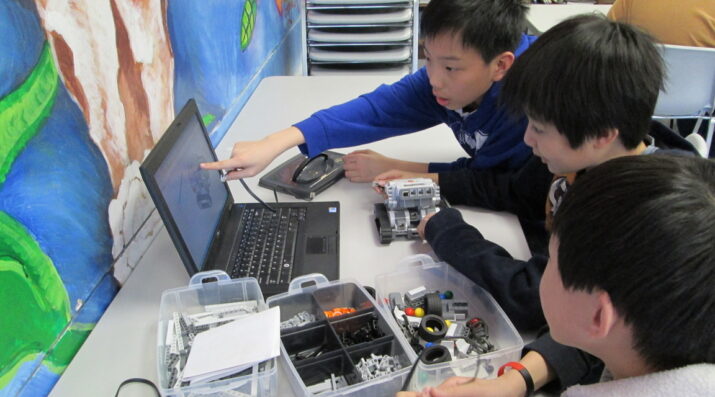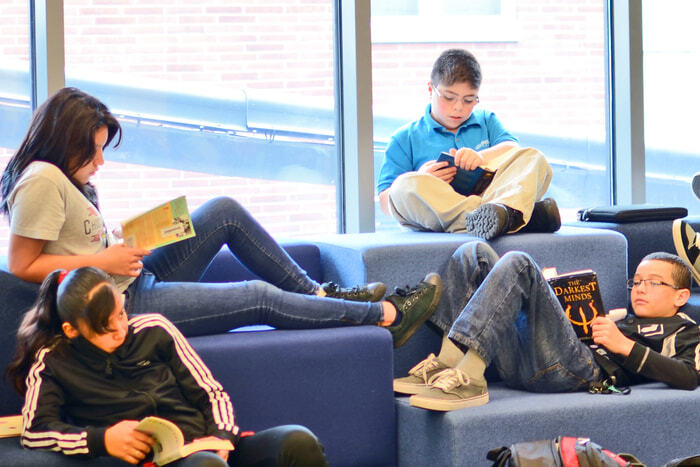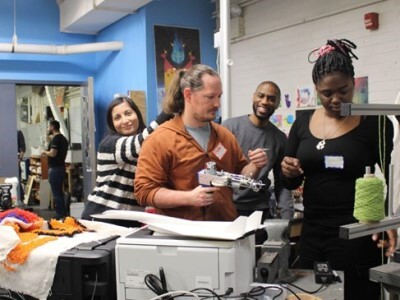Building Community
A Next Gen School for Every Child
Topics

When educators design and create new schools, and live next gen learning themselves, they take the lead in growing next gen learning across the nation. Other educators don’t simply follow and adopt; next gen learning depends on personal and community agency—the will to own the change, fueled by the desire to learn from and with others. Networks and policy play important roles in enabling grassroots approaches to change.
At the end of the day, the questions many of us ask are about how we can scale quality schools. How can we support the growth of school models that consistently and perpetually reinvent themselves in ways that ensure quality, equity, and access?
Picture yourself visiting a school, observing excited and engaged students and hearing from educators who are equally jazzed about their own experience. A colleague next to you leans in to say, “Wow! What a great school, I wish my kid went to a school like this!” Do you find yourself asking, why aren’t more kids in schools like this one? (Or, I’m lucky, my kid actually is in a school like this one.) At the end of the day, the questions many of us ask are about how we can scale quality schools. How can we support the growth of school models that consistently and perpetually reinvent themselves in ways that ensure quality, equity, and access?
At its core, the NGLC Regional Funds for Breakthrough Schools initiative is about bringing more high quality schools to more students. It’s an outgrowth and evolution of a prior investment strategy in individual next gen learning schools. Schools in the NGLC national network are beacons for what the future of K-12 education can be. They inspire. These bold, innovative school models use the most advanced learning science and educational research; integrated learning technologies, with unique applications of time, talent, and other resources; and operated sustainably on public funds.
However, they are primarily new charters, scattered across the nation, serving different communities and needs. Few schools share the same state accountability system, funding structures, or talent pipelines. Daily they bump up against policies and traditions that prevent their models from fully taking root. Sometimes they face concerns in their communities stemming from confusion about what next gen learning is and questions about the ongoing iteration that developing new kinds of schools involves.
What about the rest of the nation’s schools? The majority of students are in existing district-run schools. We won’t reach them through a national strategy that relies on creating a few excellent new schools.
By nurturing the growth of next gen learning regionally, we have found a viable way to engage many more existing district schools in the redesign process, due in large part to the role of the Regional Funds coordinating partner. The partners leverage the existing national network of NGLC schools to power locally-developed school demonstration sites. Then, they employ an ecosystem approach to support and sustain them.

The Regional Funds hold promise for the growth of next gen learning because they focus on both the ecosystem and school design.
The Regional Funds partners are positioned to remove barriers; explain the power and promise of fresh approaches while remaining sensitive to local context; engage the local community, educators, and policymakers; and provide different kinds of supports than historically may have been available. They support teacher leaders and next gen practices through local networks in which the systems context is shared. This enables a common framework for collaborative learning.
The result? In June, the six Regional Funds sites announced new grants to support next gen learning in roughly 50 schools. In the course of this one round of grantmaking, the number of next gen schools in the network doubled—increasing from just over 40 to more than 90; resulting in a more balanced portfolio—roughly half charter and half district schools.
In this blog series, I tried to uncover the strategies used by the six Regional Funds sites to achieve this level of growth and offer lessons that others can use to support next gen learning in their communities. Here are some highlights:
Regional Influences
Building an ecosystem of educational innovation looks different in different regions. Why? Because the ecosystem incorporates local culture, depends on assets in the region that are available or can be developed, and reacts to existing challenges. This diversity is a strength, it offers something for everyone and every place in terms of transferring the learning.

New Systems Designs
Scaling next gen learning isn’t just about “interesting new school designs,” as CRPE’s Robin Lake writes. It also requires taking on “politically difficult subjects” and “some pretty boring—but essential—implementation work,” she claims. Our education system was not designed for change. But to provide students with excellence, we need an education system that can adapt, that can take on “nimble and updated...central office systems and habits” and “much greater levels of dynamism in their problem solving.” The Regional Funds engage district and charter management leaders both to create the nimble, updated, dynamic conditions and dispositions that support the work of educators in their schools. Check out their wide range of approaches to school redesign.

Cultural Shifts
That shift to a nimble, dynamic system is just one part of the cultural shift that next gen learning requires. It parallels the culture of entrepreneurship, startups, and design thinking. Even though the purpose of education, a public good, is not equivalent to the goals of business, can you imagine a local educational ecosystem that embraces R&D or that continually evolves pedagogical strategies and the use of critical resources such as space, time, and talent? Examining what works and doesn’t while never losing sight of the big picture is just good professional practice. The difference in these sites may be the pace at which that iteration and reflection occurs and the commitment to informing a fluid design process that is never really finished.

Can you imagine an ecosystem that places students at the center of learning, that designs schools around their individual needs, strengths, and interests and changes as the students change? The Regional Funds partners are positioned to support educational R&D in their communities. They nurture a community of forward-leaning educators; they create space and opportunity for school teams to reflect on current practice, rethink school design, and pilot new ideas; and they serve as “champions for an innovation mindset.”
An Ecosystem of Learners
The most important element of an ecosystem for next gen learning? People. It’s the heart of reimagining professional learning and the soul of building trusting partnerships in any next gen learning ecosystem. At NGLC, we view technology as a valuable tool to support personalized learning at scale. It’s just a tool that people choose to use (or not), but our motto is this: lead with the learning. Because, in a next gen learning ecosystem, every person, from child to adult, is a learner.
This blog first appeared on Getting Smart on September 16, 2015 and is the last in a series on the Regional Funds for Breakthrough Schools. For more, stay tuned later this month for the final published project, Getting Smart on Regional Next-Gen School Design.




